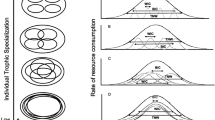Summary
Individual-based simulations were conducted to examine the effect of a small ecological neighbourhood (an area in which ecological processes such as density-dependent factors operate) and the genetic neighbourhood size (the size of an area from which the parents may be assumed to be drawn at random) on the coevolution of two competing species. For the simulations, individuals of two consumer species compete for two types of food organisms. Different genotypes (one locus and two alleles) have different efficiencies of food acquisition for different food types. Individual consumer organisms search for food within their home ranges and reproduce depending on the amount of food eaten. The dispersal distance of the offspring follows a normal distribution with a zero mean and σ d standard deviation. Simulations were conducted by varying the home range size, mating area (area from where individuals choose their mates), standard deviation of dispersal distance, food generation time, the reproductive rates of food populations and the sizes and number of independent food populations. Food organisms reproduce either within one population or independently within 16 spatially divided populations. For all the simulations, competitive exclusion was the most frequent outcome and character displacement was the least frequent outcome. Through a 200-generation simulation, the two consumer species could co-exist longer and maintain a polymorphic resource use longer when the home range and mating size were small in 16 spatially divided populations than when random mating and homogeneous interaction occurred within a community (perfect mixing population). For perfect mixing populations, the frequency of character displacement increased as the food generation time became short and the reproductive rates of food decreased. It follows from the results that the sizes of the genetic and ecological neighbourhoods and the mode of resource dynamics can affect the evolution of two competing species.
Similar content being viewed by others
References
Abrams, P.A. (1987) Alternative models of character displacement and niche shift. 2. Displacement when there is competition for a single resource.Am. Nat. 130, 271–82.
Abrams, P.A. (1989) The importance of intraspecific frequency-dependent selection in modelling competitive coevolution.Evol. Ecol. 3, 215–20.
Addicott, J.F., Aho, J.M., Antolin, M.F., Padilla, D.K., Richardson, J.S. and Souk, D.A. (1987) Ecological neighborhoods: scaling environmental patterns.Oikos 49, 340–6.
Antonovics, J. and Levin, D.A. (1980) The ecological and genetic consequences of density-dependent regulation in plants.Ann. Rev. Ecol. Syst. 11, 411–52.
Brown, J.S. and Vincent, T.L. (1987) Coevolution as an evolutionary game.Evolution 41, 66–79.
Bulmer, M.G. (1974) Density-dependent selection and character displacement.Am. Nat. 108, 45–58.
Case, T.J. (1981) Niche packing and coevolution in competitive communities.Proc. Natl Acad. Sci. USA 8, 5021–5.
Caswell, H. and Cohen, J.E. (1991) Communities in patchy environments: a model of disturbance, competition, and heterogeneity. InEcological Heterogeneity (J. Kolasa and S.T.A. Pickett, eds), pp. 97–122. Springer-Verlag, New York.
Crozier, R. (1974) Niche shape and genetical aspects of character displacement.Am. Zool. 14, 1151–7.
DeAngelis, D.L. and Gross, L.J. (eds) (1992)Individual-based Models and Approaches in Ecology. Chapman & Hall, London.
Felsenstein, J. (1975) A pain in the torus: some difficulties with models of isolation by distance.Am. Nat. 109, 359–68.
Felsenstein, J. (1976) The theoretical population genetics of variable selection and migration.Ann. Rev. Genet. 10, 235–80.
Frenchel, T.M. and Christiansen, F.B. (1977) Selection and interspecific competition. InMeasuring Selection in Natural Populations (F.B. Christiansen and T.M. Frenchel, eds), pp. 477–98. Springer-Verlag, New York.
Hanski, I. (1983) Coexistence of competitors in patchy environment.Ecology 64, 493–500.
Hartle, D.L. (1988)A Primer of Population Genetics (2nd edn). Sinauer, Sunderland, MA.
Itô, Y. and Murai, M. (1977)Methods in Animal Ecology. Kokin shoin, Tokyo (in Japanese).
Judson, O.P. (1994) The rise of the individual-based model in ecology.Trends Ecol. Evol. 9, 9–16.
Kawata, M. (1995) Effective population size in a continuously distributed population.Evolution 49, 1046–54.
Levin, D.A. (1987) Local differentiation and the breeding structure of plant populations. InPlant Evolutionary Biology (G.L.D. Jain and S.K. Jain, eds), pp. 305–25. Chapman & Hall, London.
Ludwig, J.A. and Reynolds, J.F. (1988)Statistical Ecology. Wiley and Sons, New York.
Morisita, M. (1959) Measuring of the dispersion of individuals and analysis of the distribution patterns.Mem. Fac. Sci. Kyushu Univ. Ser. E. (Biol.) 1, 187–97.
Roughgarden, J. (1976) Resource partitioning among competing species — a coevolutionary approach.Theor. Pop. Biol. 9, 388–424.
Rummel, J.D. and Roughgarden, J. (1993) Some differences between invasion-structured and coevolution-structured competitive communities: a preliminary theoretical analysis.Oikos 41, 477–86.
Slatkin, M. (1980) Ecological character displacement.Ecology 61, 163–77.
Taper, M.L. and Case, T.J. (1985) Quantitative genetic models for the coevolution of character displacement.Evolution 66, 355–71.
Taper, M.L. and Case, T.J. (1992a) Coevolution among competitors.Oxford Surv. Evol. Biol. 8, 63–109.
Taper, M.L. and Case, T.J. (1992b) Models of character displacement and the theoretical robustness of taxon cycles.Evolution 46, 317–33.
Wright, S. (1943) Isolation by distance.Genetics 28, 139–56.
Wright, S. (1946) Isolation by distance under diverse systems of mating.Genetics 31, 39–59.
Author information
Authors and Affiliations
Rights and permissions
About this article
Cite this article
Kawata, M. The effects of ecological and genetic neighbourhood size on the evolution of two competing species. Evol Ecol 10, 609–630 (1996). https://doi.org/10.1007/BF01237710
Issue Date:
DOI: https://doi.org/10.1007/BF01237710




